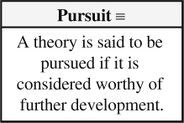Theory Pursuit
What is pursuit? How should it be defined?
Pursuit is one of the key concepts in current scientonomy. Thus, its proper definition is of great importance.
In the scientonomic context, this term was first used by Hakob Barseghyan in 2015. The term is currently accepted by Scientonomy community.
In Scientonomy, the accepted definition of the term is:
- A theory is said to be pursued if it is considered worthy of further development.
Contents
Scientonomic History
Acceptance Record
| Community | Accepted From | Acceptance Indicators | Still Accepted | Accepted Until | Rejection Indicators |
|---|---|---|---|---|---|
| Scientonomy | 1 January 2016 | Yes |
All Theories
| Theory | Formulation | Formulated In |
|---|---|---|
| Theory Pursuit (Barseghyan-2015) | A theory is said to be pursued if it is considered worthy of further development. | 2015 |
If an answer to this question is missing, please click here to add it.
Accepted Theories
| Community | Theory | Accepted From | Accepted Until |
|---|---|---|---|
| Scientonomy | Theory Pursuit (Barseghyan-2015) | 1 January 2016 |
Suggested Modifications
Current View
Currently, a theory is said to be pursued if it is considered worthy of further development. 1p. 31
In Scientonomy, the accepted definition of the term is Theory Pursuit (Barseghyan-2015).
Theory Pursuit (Barseghyan-2015) states: "A theory is said to be pursued if it is considered worthy of further development."
A theory is said to be pursued if it is considered worthy of further development. 1pp. 30-42 An example is provided by mid-seventeenth century science. Throughout this period, the Aristotelian natural philosophy, with its geocentric cosmology, four elements, and four causes remained accepted by the scientific community of Europe as evidenced, for example, by its central place in university curricula. The theories from this period that we are most familiar with from modern popular and professional literature, like Copernicus's heliocentric cosmology, and Galileo's theories of motion, were not accepted, but pursued theories. More generally these included the mechanical natural philosophy championed by a community which included Descartes, Huygens, Boyle, and many others, and the magnetical natural philosophy, espoused by Gilbert, Kepler, Stevin, Wilkins and others. In our modern world, the major accepted physical theories include Einstein's relativity theory, quantum mechanics, and the standard model of particle physics. A variety of other theories are not accepted but are being pursued. These include various versions of string theory, and attempts to quantize general relativity, to create a quantum theory of gravity.1p. 40
While a variety of unaccepted theories are typically pursued, accepted theories also typically continue to be pursued. General relativity has been the accepted theory of gravitation since roughly 1918. 1p. 203 The theory and its implications for astrophysics and cosmology continue to be pursued in a variety of ways. For example, in 2016, researchers at the Laser Interferometer Gravitational-Wave Observatory in the United States announced the first-ever direct detection of gravitational waves, thereby verifying a major prediction of the theory. 23
Related Topics
This question is a subquestion of Theory.
This topic is also related to the following topic(s):
References
- a b c d Barseghyan, Hakob. (2015) The Laws of Scientific Change. Springer.
- ^ Castelvecchi, Davide and Witze, Alexandra. (2016) Einstein's Gravitational Waves Found at Last. Nature. Retrieved from https://www.nature.com/news/einstein-s-gravitational-waves-found-at-last-1.19361.
- ^ Abbott, Benjamin. (2016) Observation of Gravitational Waves from a Binary Black Hole Merger. Physical Review lettters 116, 061102. Retrieved from https://journals.aps.org/prl/abstract/10.1103/PhysRevLett.116.061102.
